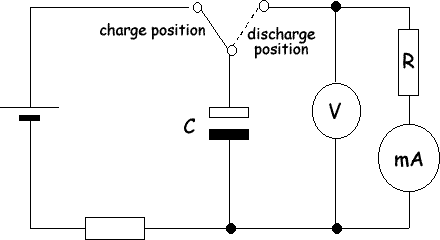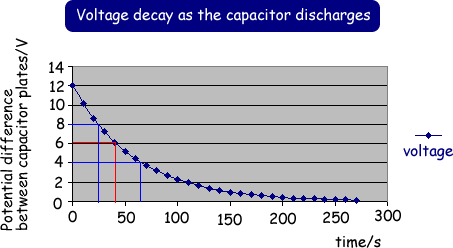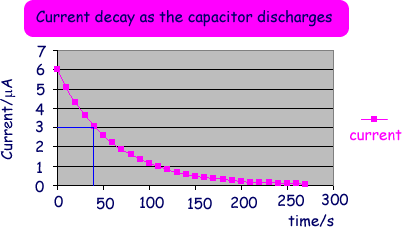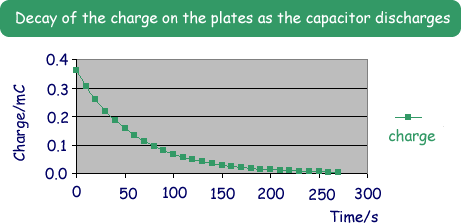Capacitor Discharge Graphical Representation and Quantitative Treatment of Capacitor Discharge
The decay of charge in a capacitor is similar to the decay of a radioactive nuclide. It is exponential decay. If we discharge a capacitor, we find that the charge decreases by half every fixed time interval - just like the radionuclides activity halves every half life. If it takes time t for the charge to decay to 50 % of its original level, we find that the charge after another t seconds is 25 % of the original (50 % of 50 %). This time interval is called the half-life of the decay. The decay curve against time is called an exponential decay. The voltage, current, and charge all decay exponentially during the capacitor discharge. We can perform an experiemnt to obtain the data for us to plot a graph to show this by using the circuit below:
We can charge up the capacitor and then flip the switch and record the voltage and current readings at regular time intervals and plot the data, which gives us the exponential graphs below. Let us use a voltage of 12V to charge up a 30 Note the following about the graphs:
Note that the 'half life' is the same as for voltage
The graphs are asymptotic (like the one for radioactive decay) , i.e. in theory the capacitor does not completely discharge but in practice, it does.
The graph is described by the relationship: Q = Q0 e –t/RC Compare this to the radioactive decay equation:
the decay constant The product RC (capacitance of the capacitor × resistance it is discharging through) in the formula is called the time constant. The units for the time constant are seconds.
We can show that ohms × farads are seconds.
So if we discharge the capacitor for RC seconds, we can easily find out the fraction of charge left: V= V0 e –RC/RC = V0 e –1 = 0.37 V0 So, after RC seconds the voltage is 37 % of the original.
This fact is used widely by electronic engineers. To increase the time taken for a discharge we can:
We can link the half-life to the capacitance. Q = 1/2 Q0 t = t1/2 Q0/2 = Q0 e – t1/2/RC
½ = e – t1/2/RC
2-1 = e – t1/2/RC
e + t1/2/RC = 2
ln (2) = t1/2/RC
t1/2 = loge (2) × RC
t1/2 = 0.693 × RC So, the half-life is 69.3 % of the time constant.
|
Follow me...
|











